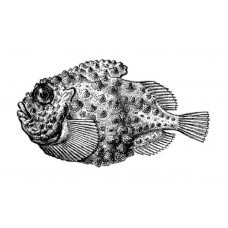Latin name
Eumicrotremus derjugini
Other name
Petite poule de mer Arctique
Identification
It differs from closely related species in having a dorsal fin that is completely submerged under the skin, forming a fleshy prominence with small tubercles on top and large tubercles on the sides, as well as tubercles-free surfaces on the base of the pectoral fins, most of the chin, and the throat. There are about 4-5 tubercles in the pectoral row. Conical tubercles on the body are shallower than in Eumicrotremus spinosus and Eumicrotremus orbis, more sparsely arranged, and not grouped in regular rows. Trunk tubercles, gradually flattening, continue in 2 rows to caudal peduncle. Interorbital space covered with small, low tubercles. There are no enlarged tubercles along the first dorsal fin and anterior to the base of the anal fin. Skin appendages on the chin are absent. The sucking disc is smaller than in Eumicrotremus spinosus, its longitudinal diameter is equal to the length of the base of the anal fin. The distance between the posterior margin of the disc and the anal opening does not exceed the diameter of the eye and is without folds. The conical tubercles on the body develop much later than in the previous two species, with the first tubercles appearing on the body rather than on the top of the head.
Features of fish fins
Dorsal spines (total): 7; Dorsal soft rays (total): 11 - 13. Caudal fin rounded. The spines on the dorsal fin are not visible. The first dorsal fin is low, covered with thick fleshy skin (the rays are completely indistinguishable) and small tubercles.
Fish colouring
The body of the Leatherfin Lumpsucker is olive, darker on the back. The coloration of the upper side of the body is darker than that of Eumicrotremus spinosus.
Distribution
This species is distributed in the Northwest Atlantic and Northwest Pacific: from Hudson Bay, Ungava and Labrador in Canada. In the Arctic Ocean, Barents Sea, near Franz Josef Land, Svalbard, east of Greenland, in the Kara Sea, Laptev Sea, Siberian and Chukchi Seas, and the Sea of Okhotsk.
Habitat
A polar marine species. Leads a bottom-dwelling lifestyle. Found at depths of 50-930 m. Found on muddy, pebbly and stony bottoms at temperatures below 0 °С. Juveniles are found in shallow waters.
Size
The maximum length of the male of this species is 10.0 cm.
Behavior
The Leatherfin Lumpsucker is found on muddy, gravelly or rocky bottoms at temperatures below 0°C. Juveniles live in shallow water.
Food and feeding habits
Leatherfin lumpsuckers feed on bottom-feeding crustaceans.
Reproduction
The biology of this species is not well understood. Juveniles apparently hatch in early summer and reach a length of 25-28 mm by August - early September. Juveniles remain near shore, but yearlings (32-42 mm) are found at depth with adults.
Fishing
This species is not commercially important.
Relationship with a person
Harmless.
| Classification | |
| Phylum | Chordata |
| Class | Actinopterygii |
| Squad | Perciformes |
| Family | Cyclopteridae |
| Genus | Eumicrotremus |
| Species | E. derjugini |
| Features | |
| Conservation status | Not Evaluated |
| Habitat | Bottom |
| Life span, years | No information |
| Maximum body weight, kg | No information |
| Maximum length, cm | 10 |
| Sailing speed, m/s | No information |
| Threat to people | Edible |
| Way of eating | Bentophage |
Leatherfin lumpsucker
Tags: leatherfin lumpsucker

